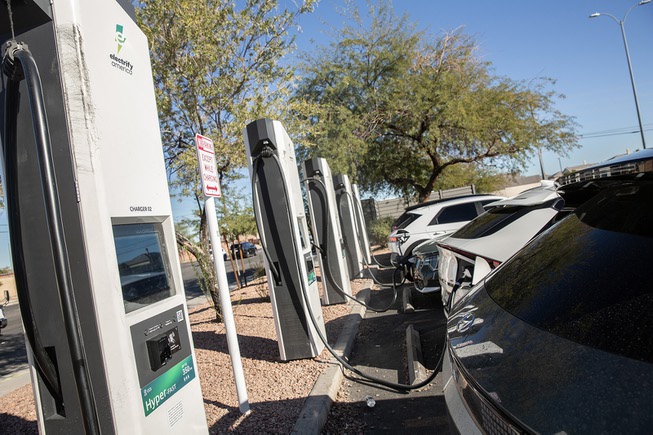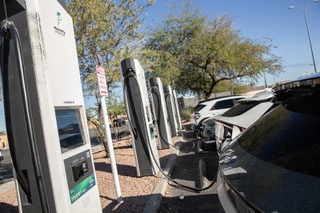
Various electric vehicles are seen charging at the Electrify America charging station in the Southern Premium Outlets parking lot, Tuesday Nov. 21, 2023.
Monday, Dec. 4, 2023 | 2 a.m.
Electric cars are making a dent in Las Vegas’ air pollution, but charging infrastructure is still limited and drivers statewide aren’t adopting the technology fast enough to reach emissions goals.
Take Will Gibbs, an Uber driver who swears by his electric 2022 Kia EV6 GT-Line and says he often finds himself waiting on line for a charger.
“I need it every single day, so it becomes a real problem,” said Gibbs, who was charging his vehicle at the Las Vegas South Premium Outlets on Warm Springs Road and Las Vegas Boulevard.
Still, he said, the benefits of his electric vehicle outweigh any inconveniences. And he’s not the only one who is going electric.
The Alliance for Automotive Innovation, a trade association and lobbying group, reported 41,441 electric vehicle sales in Nevada from 2011 to August 2023. But annual sales peaked in 2022 at 12,384 and are expected to grow. Additionally, California had 1.5 million electric car sales from 2011 to 2023 — some of which could be part of the 48,000 people who relocated to Nevada in the past year, according to the U.S. Census Bureau.
That means the charging infrastructure needs to continue evolving.
Nevada has 1,895 public electric vehicle chargers at 562 locations, according to the U.S. Department of Energy’s Alternative Fuels Data Center, That’s up from 1,663 chargers at 478 locations in 2022 and 1,162 chargers at 298 locations in 2021.
The number of chargers will continue to grow with the Nevada Department of Transportation receiving $38 million over the next five years as part of the Infrastructure Investment and Jobs Act to fund new public charging infrastructure.
NDOT says it will prioritize using that money to place chargers every 50 miles along state highways. It could also apply for $2.5 billion in federal funding to enhance the electric vehicle charging options.
The Nevada Climate Initiative and the U.S. government aim for zero emissions by 2050, but the Nevada Department of Environmental Protection estimates Nevada will fall short of those goals if local and state governments don’t take bigger steps.
Clark County aligned its climate goals with the Paris Agreement, an international agreement between 195 countries to combat climate change worldwide, in 2015. Under the agreement, the U.S. plans to reach a 26% to 28% emissions reduction from 2005 levels by 2025.
According to the All-In Clark County climate initiative, the county should aim to cut emissions by 30% to 35% from its 2019 baseline by 2030 to match the pace of reduction the state aims to achieve.
Lung-Wen Antony Chen, an associate professor at UNLV’s Urban Air Quality Laboratory, gained some insight into what an electrified future could look like for Southern Nevada during the early months of the pandemic.
Research he worked on during pandemic business closures in 2020 showed a 49% reduction of the nitrogen dioxide in the air from mid-March to the end of April 2020 in the Las Vegas Valley because fewer cars were on the roads. Carbon monoxide and particulate matter also decreased.
“That’s what happened when we had very few vehicles on the road, but it would be a similar situation if all vehicles switched to electric vehicles,” Chen said.
The Nevada Division of Environmental Protection reported a 16% emissions drop from 2019 to 2020.
On the other hand, increased electricity consumption means Nevada’s power plants need to produce more energy. But Chen said the benefits would still outweigh the environmental costs by a wide margin.
As EVs catch on and tailpipe emissions drop, the environmental focus on cars would shift to non-tailpipe emissions such as tire and brake wear, Chen said.
Under constant stress friction, those parts break down slowly over time and scatter tiny rubber and polymer particles.
The California Air Resources Board, part of the California EPA, already considers those emissions just as much of a priority as tailpipe emissions.
“At a certain time, the non-tailpipe emissions are going to exceed the tailpipe emissions and that means the brake and tire wear will become the dominant source of air pollution from the transportation sector,” Chen said. “The question is when that time comes.”
rhiannon.saegert@gmg vegas.com / 702-948-7836 / @Missmusetta

